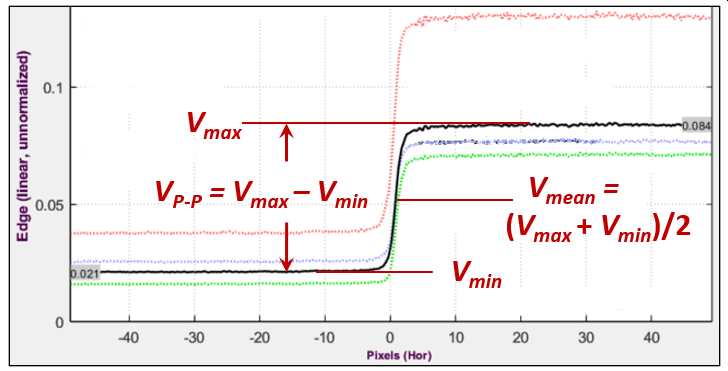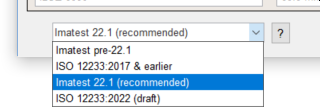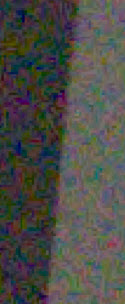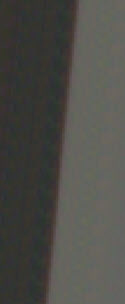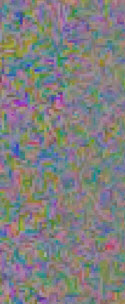|
News: Imatest 23.1 (March 2023) (available in the Imatest Pilot program). New methods for calculating camera information capacity, Noise Power Spectrum (NPS), Noise Equivalent Quanta (NEQ), and Ideal observer SNR (SNRi) from slanted-edge patterns are now available. |
|
Shannon information capacity can also be calculated from images of the Siemens star, described in the 2020 white paper, Camera information capacity: a key performance indicator for Machine Vision and Artificial Intelligence systems.
The Siemens star method was presented at the Electronic Imaging 2020 conference, and published in the paper, “Measuring camera Shannon information capacity from a Siemens star image“. See also the Imatest News Post: Measuring camera Shannon information capacity with a Siemens star image. The 2020 white paper, Camera information capacity: a key performance indicator for Machine Vision and Artificial Intelligence systems, is a more readable introduction to the Siemens Star measurement. This page presents new calculations of information capacity and other measurements from slanted edges. |
Introduction – Acquiring and framing – Running the MTF module – Results – Edge/MTF plot
Edge/noise plot – 3D plot and Total information capacity – Summary – Links –
Appendix 1: Calculation summary – Appendix 2: Meaning of Information capacity
Nothing like a challenge! There is such a metric for electronic communication channels— one that quantifies the maximum amount of information that can be transmitted through a channel without error. The metric includes sharpness and noise (grain in film). And a camera— or any digital imaging system— is such a channel.
The metric, first published in 1948 by Claude Shannon* of Bell Labs [1,2], has become the basis of the electronic communication industry. It’s called the Shannon channel capacity or Shannon information capacity C, and has a deceptively simple equation [3]. (See the Wikipedia page on the Shannon-Hartley theorem for more detail.)
\(\displaystyle C = W \log_2 \left(1+\frac{S}{N}\right) = W \log_2 \left(\frac{S+N}{N}\right) = \int_0^W \log_2 \left( 1 + \frac{S(f)}{N(f)} \right) df\)
W is the channel bandwidth, S(f) is the signal energy (the square of signal voltage; proportional to MTF(f)2), and N(f) is the noise energy (the square of the RMS noise voltage), which corresponds to grain in film. It looks simple enough (only a little more complex than E = mc2 ), but it’s not easy to apply.
*Claude Shannon was a genuine genius. The article, 10,000 Hours With Claude Shannon: How A Genius Thinks, Works, and Lives, is a great read. There are also a nice articles in The New Yorker and Scientific American. The 29-minute video “Claude Shannon – Father of the Information Age” is of particular interest to me it was produced by the UCSD Center for Memory and Recording Research. which I frequently visited in my previous career.
This page describes how to calculate information capacity C from images of slanted-edges, Imatest’s most widely-used test image, which (thanks to a recent discovery) allows signal and noise to be calculated from the same location, resulting in a superior measurement of image quality. The earlier (2020) Siemens star method is described in Shannon information capacity from Siemens stars.
Introduction to the new measurements
This page describes several image quality measurements introduced in Imatest 23.1, released in March 2023. These measurements take advantage of newly-discovered properties of slanted edges– Imatest’s most widely used patterns for measuring MTF. Most are unfamiliar because they have been traditionally difficult to perform. We describe two new measurement methodologies. The Edge variance method, conveniently calculates camera information capacity. The Noise image method uses a different approach to calculate information capacity and several additional image quality factors. We introduce the new calculations, show show how to obtain them, present Key Results, then present detailed algorithms in Appendix 1: Calculation summary and algorithms.
A: Edge variance method.
Sum the squares of the scan lines to obtain the edge variance.
The Edge variance Information capacity calculation is described in detail in the white paper, New Slanted-Edge Image Quality Measurements: the Edge variance method for Camera Information Capacity and in the paper presented at Electronic Imaging 2023, “Measuring Camera Information Capacity with Slanted Edges” (now on the Imatest website: we’ll use the IS&T EI2023 link when it’s available). The descriptions on this page are very concise, omitting details in the two linked documents.
Starting with images of slanted edges, (Original ROI, below), typically made from a 4:1 contrast chart (chart contrasts between 2:1 and 10:1 are acceptable), the standard slanted-edge algorithm finds the center of each scan line (taken in a direction approximately normal to the edge), fits the centers to a polynomial curve, then, depending on the location of the polynomial at the scan line, it adds the contents of the scan line to one of four bins. These mean values of each bin are then interleaved to form a 4× oversampled edge, which has lower noise than any of the individual scan lines.
The Edge variance method adds another summation. The squares of each scan line are added to the appropriate bin to calculate the variance of the edge signal, σ2, which is equivalent to its noise power, N. The mean signal amplitude for a uniformly-distributed signal of peak-to-peak amplitude VP-P is \(S(f) = V_{P-P} MTF(f) / \sqrt{12}\) — a reasonable number to use for the information capacity calculation using the Shannon-Hartley equation, shown above.
The key results are,
C4 is the direct result of measuring 4:1 contrast ratio slanted-edges. It is calculated from the Shannon Hartley equation, using several assumptions (that the signal is uniformly distributed over the peak-to-peak measurement and the noise power spectral density (NPD) is flat). C4 is a special case of Cn, for a n:1 contrast ratio (with ISO standard 4:1 strongly recommended) Cn is sensitive to chart contrast ratio and exposure, making it interesting for measuring performance as a function of exposure but less robust than ideal for calculating a camera’s maximum information capacity.
Cmax is a much more stable measurement of the maximum information capacity for the camera starting with C4 (for the 4:1 contrast chart). It is also insensitive to exposure, at least for linear sensors, where noise is a known function of signal voltage.
B. Noise image method
Subtract a low-noise de-binned / reverse-projected ROI image to obtain a noise image.
This method involves inverting the ISO 12233 binning procedure. Noting that the 4× oversampled edge was created by interleaving the contents of 4 bins, we apply an inverse of the binning algorithm to set the contents of each scan line to its corresponding bin (Inverse binned… ROI, below). Since the inverse-binned image is nearly noiseless, we can create a noise image by subtracting the inverse-binned image from the original image. This image is shown, adjusted to make the mean (zero) value middle gray, as the Noise image ROI, below.
The key results, many familiar from medical radiology, are,
Noise Power Spectrum, NPS(f). NPS was implicitly assumed to be constant (white noise) in the Edge variance method.
Noise Equivalent Quanta, NEQ(f) and NEQinfo(f) are measures of frequency-dependent signal-to-noise ratio (SNR). \(NEQ(f) = \mu^2\ MTF^2(f) / NPS(f)\text{, where }\mu = V_{mean}\) has been used for quantifying medical image quality, but are much less familiar in general imaging. NEQ(f) is equivalent to the number of quanta detected by the sensor when photon shot noise is dominant. It is appropriate for calculating Digital Quantum Efficiency (DQE), when the density of quanta reaching the image sensor is known. NEQinfo(f) is derived from \(\mu = V_{P-P} / \sqrt{12}\), making it well-suited for calculating information capacity CNEQ.
Information capacities C4-NEQ and Cmax-NEQ, which correspond to C4 and Cmax from the Edge variance method, but are derived from NEQinfo(f). They are close, but not identical.
Ideal observer Signal-to-Noise Ratio, SNRi From Skorka and Kane [9], “The Ideal Observer is a Bayesian decision maker that maximizes the statistical precision of a hypothesis test with two possible outcomes.” SNRi as we present is, is a metric of the detectability of small objects (squares or rectangles), typically of low contrast.
Why two methods?The Edge variance was developed first, starting in late October 2022. It was presented at the Electronic Imaging 2022 conference. The Noise image was developed in February 2023, about a month after the conference. It measures more image quality parameters than the Edge variance method. We currently recommend the Noise image method because we believe the camera information capacity measurement is slightly more accurate. The reason: it calculates the Noise Power Spectrum, while the Edge variance assumes the NPS is flat (white). On the other hand, The Edge variance method can provide useful (if imperfect) results for bilateral-filtered images (most JPEGs from consumer cameras), while the Noise image method is only recommended for uniformly or minimally-processed images. |
Obtaining the new results in Imatest
Acquire the image
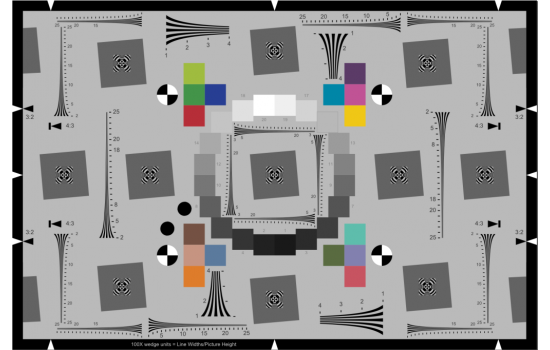
The eSFR ISO chart. Automatically detected ROIs, combining MTF, color, tone, and noise measurements
Acquire a well-exposed image of any slanted-edge test chart (SFRplus, eSFR ISO, Checkerboard, SFRreg, or SFR) in even, glare-free light. Chart edge contrast ratio should be 4:1 (the ISO 12233 standard) where possible (the limits are 2:1 to 10:1). For the most part, acquiring the image is identical to standard MTF measurements.
Exposure consistency is important because exposure affects the information capacity measurement. (It’s only a second-order effect for MTF measurements.) The mean pixel level of a perfectly exposed slanted-edge region should be in the range of 0.20 to 0.26.
For best results the slanted edge should be 100 pixels or more along the edge. Fewer pixels will work, but the results will be less consistent.
Run the MTF calculation module
Run either an appropriate Rescharts module (interactive; recommended for starting and making settings — SFRplus Setup, eSFR ISO Setup, SFRreg Setup, or Checkerboard Setup in the second column in the Imatest main window) or an appropriate fixed, batch-capable module (SFR, SFRplus Auto, eSFR ISO Auto, SFRreg Auto, or Checkerboard Auto buttons in the left column).
In the Settings window, select the appropriate setting in the Information capacity display dropdown menu. It may be somewhat inconspicuous.
All settings except No information capacity… perform both the Edge variance and Noise image calculations. Calculating information capacity slows down operations slightly. These settings affect the Edge/MTF display, which has limited space. Results from both methods are displayed in the Noise Spectrum, NEQ, SNRi plot when Results summary is selected for the lower plot.
- No information capacity calculation is just slightly faster either of the information capacity calculations. About the only time you’d want this setting would be for high-speed realtime image acquisition.
- Calculate info cap: Auto edge noise detection (best) Selects either Method (1) or (2) depending on the detection of a noise peak. Often recommended, but we have found that it sometimes misses the peak in bilateral-filtered images. One of the next two choices is recommended if you predominantly use one file type (either minimally/uniformly processed or bilateral-filtered).
- Calculate info cap using mean edge noise (default) (Method (1)) for images converted from raw with minimal or uniform processing (no bilateral filtering).
- Calculate info cap using smoothed peak noise (Method (2)) for bilateral-filtered images, which includes most JPEG images from consumer cameras. It works for uniformly-processed images, but gives less stable results than Method (1).
- Calculate info cap – Auto & NEQ Display NEQ Calculate information capacity using both methods (using Auto edge noise detection for the Edge variance method), but display the results of the Noise image method in the Edge/MTF plot. This is our current recommendation for minimally/uniformly processed images.
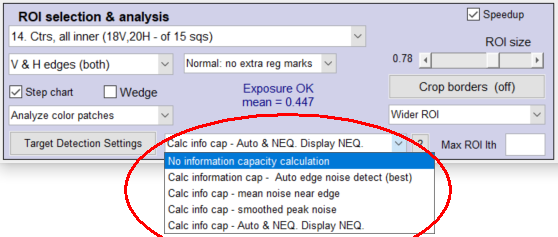 Crop of the Settings window, showing information capacity noise setting.
Crop of the Settings window, showing information capacity noise setting.
The full window and complete instructions are in SFRplus, eSFR ISO, Checkerboard, SFRreg, or SFR
When OK is pressed the image is analyzed. Any of several displays can be selected in Rescharts, but only a few (shown below) are related to information capacity. The same results can be obtained from running fixed modules.
From the Rescharts interactive interface, the noise calculation can always be set (or changed) from a dropdown menu on the left of the More settings window. This setting is also in the SFR and Rescharts SFR Settings windows.
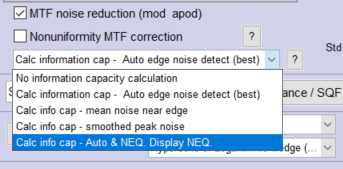 Information capacity noise calculation, from left side of More settings window
Information capacity noise calculation, from left side of More settings window
In the lower-left of the More settings window, choose one of the Imatest calculations, preferably Imatest 22.1 (recommended). At this writing there are some problems with the ISO calculations: we will remove this message when they’re fixed.
Key results
Edge/MTF plot
Information capacity (for the individual edge) has been added to the upper (Edge) plot. Nothing else has changed.
The image below is from a raw-converted eSFR ISO chart image from a high quality compact camera.
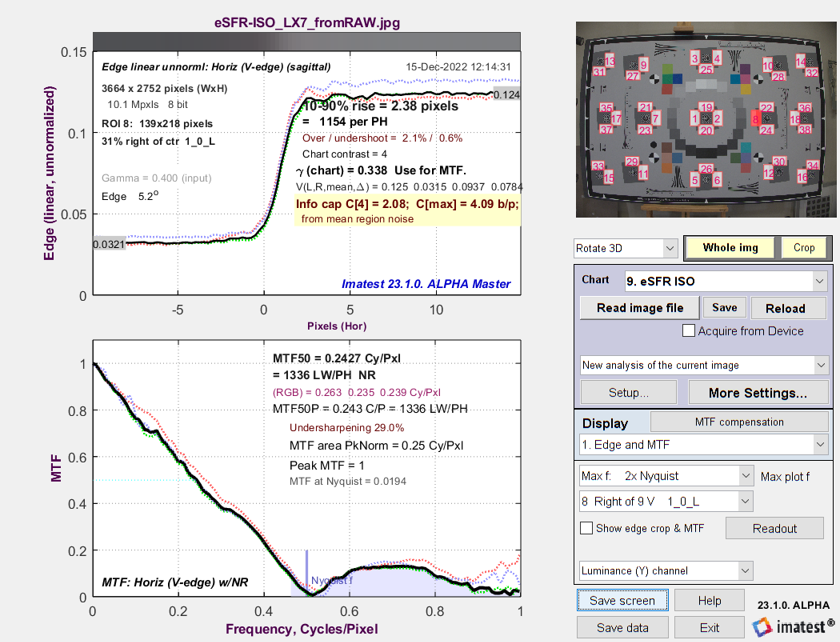 Edge/MTF Results from eSFR ISO image converted from raw with minimal processing
Edge/MTF Results from eSFR ISO image converted from raw with minimal processing
Both information capacity C4 (for 4:1 contrast charts; very sensitive to exposure) and Cmax (maximum information capacity; relatively insensitive to exposure) are displayed.
Edge & Info Capacity Noise
This is a variant of the Edge and MTF plot. The top plot is similar (though the Line Spread Function — the derivative of the edge — is of special interest for this plot).
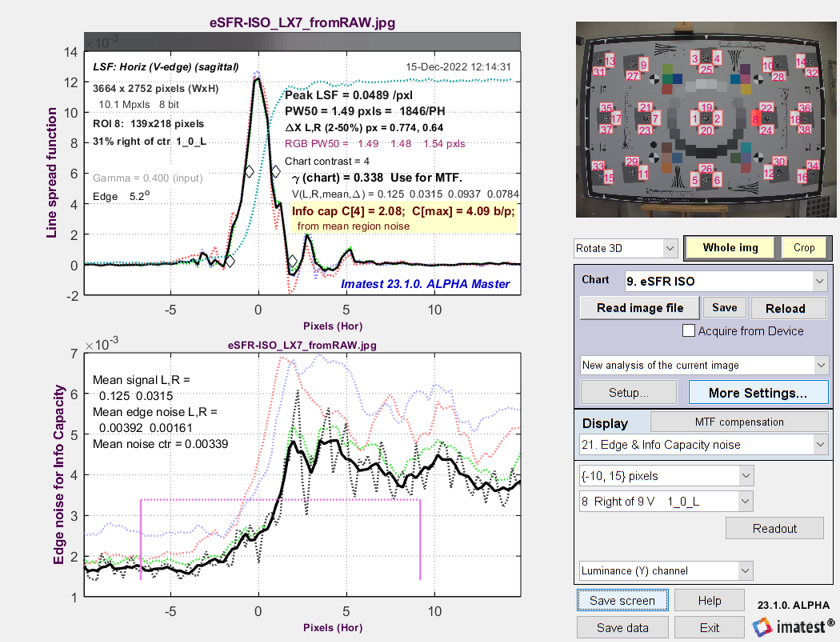 Line Spread Function (LSF) and signal-dependent noise σ from
Line Spread Function (LSF) and signal-dependent noise σ from
eSFR ISO image converted from raw with minimal processing
The solid line is the noise smoothed by a rectangular kernel with width = 5 (4× oversampled) pixels (1.25 original pixels). Note that the noise is very rough and that there is no distinct peak near the edge transition. From observing regions of the chart, the bumps on the noise curve appear to be random and not repeatable.
Now it gets interesting. The image used for the above plots is derived from a raw image with minimal processing (straight gamma curve; no sharpening or noise reduction — and definitely NO bilateral filtering). Here are results for the in-camera JPEG from the same acquisition. Note the large noise peak near the edge. We use Method (1) to calculate noise for the Shannon-Hartley equation, which takes the average over a fairly wide region near the edge.
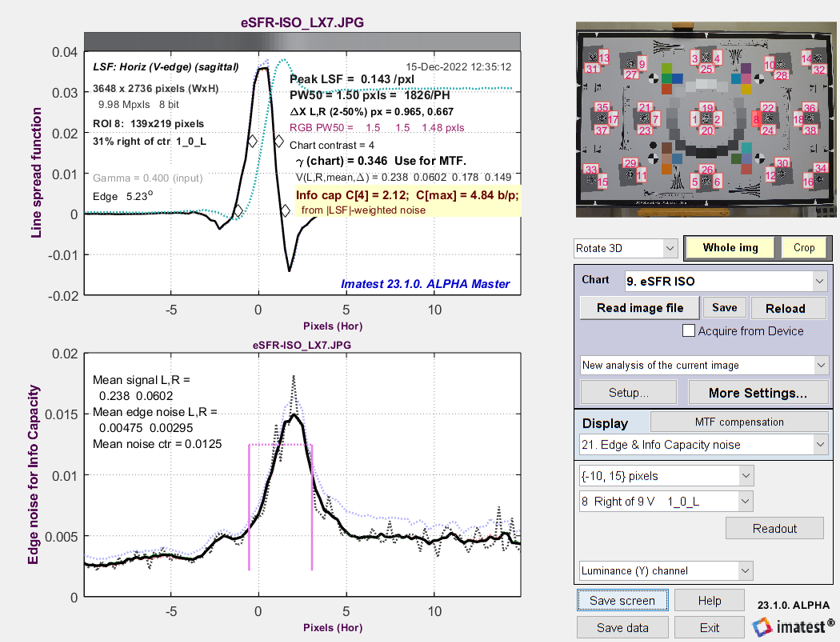 Line Spread Function (LSF) and signal-dependent noise σ from
Line Spread Function (LSF) and signal-dependent noise σ from
eSFR ISO image captured as a JPEG (with strong sharpening and bilateral filtering)
Method (2): Calculate noise for info cap using the maximum value of the smoothed edge noise. This method is recommended for bilateral-filtered JPEGs because it uses a relatively narrow region near the noise peak for measuring noise. Information capacity C4 = 3.11 b/p is only slightly higher than for the TIFF: 3.0 b/p. If Method (1) (averaging over a large area, which doesn’t emphasize the peak) is chosen, C4 = 3.84 b/p: significantly larger than the raw measurement, and clearly not accurate.
3D plot and total information capacity
C4 and Cmax have been added to the available 3D plots.
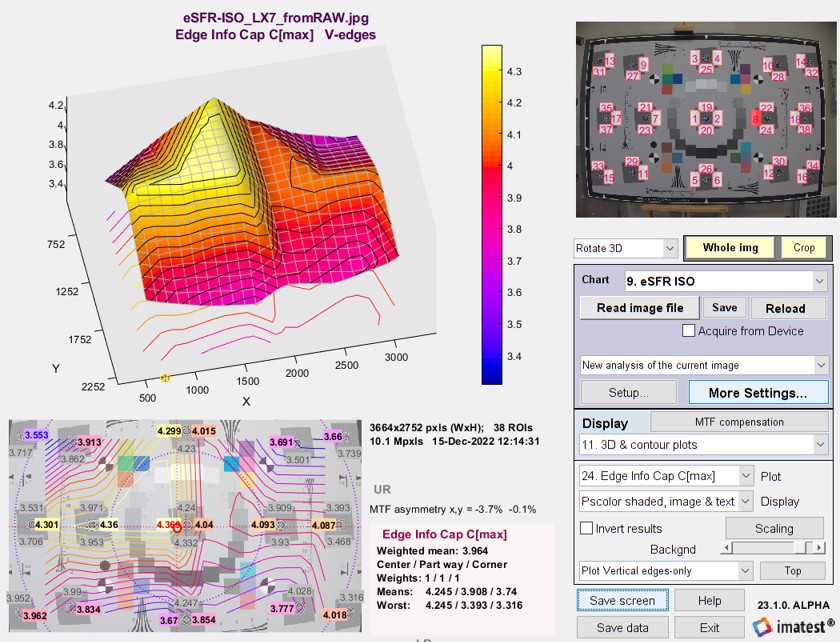 3D plot of Edge Information capacity C4
3D plot of Edge Information capacity C4
The total information capacity Ctotal (referenced to the signal level: in this case 4:1) is calculated by multiplying the weighted mean (with all weights are set to 1 for the two information capacity plots) in bits per pixel by the total number of megapixels. It is displayed next to the mean information capacity (in bits per pixel).
In the above image, Ctotal = 2.847 bits/pixel × 16 megapixels = 45.44 megabits. The display shows Edge Info Cap Cmax Mean: 2.847; total Mb: 45.44.
Results for NPS, NEQ, and SNRi from 2D de-interleaved images.
The new results (NPS, NEQ, SNRi) and an old one (MTF) can be displayed in the 9. Noise Spectrum, NEQ, SNRi plot. This plot shows results for all available color channels. A 24 megapixel Micro Four-Thirds camera with a high quality 60mm lens set to f/8 and ISO 100 was used to obtain these results.
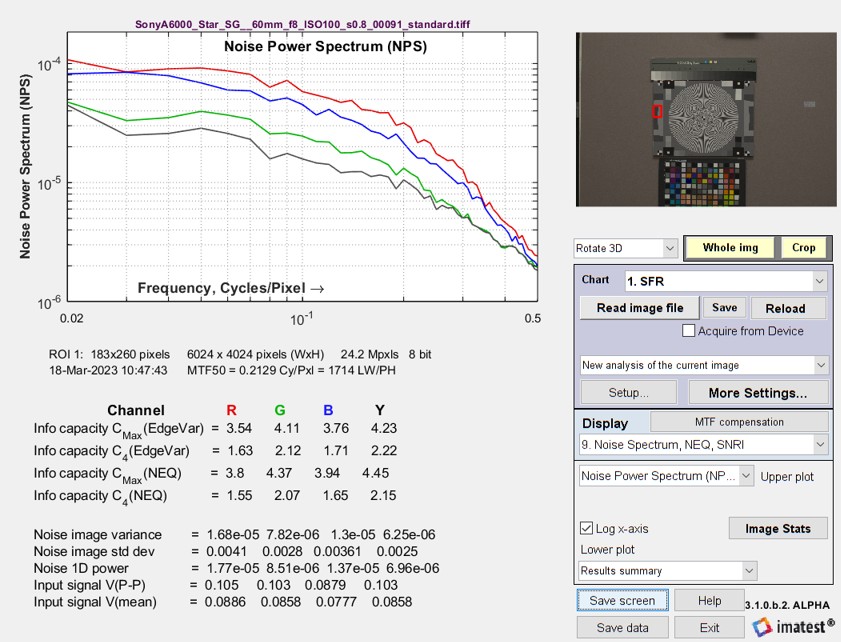 Noise Power Spectrum (NPS) plot and results summary from Rescharts
Noise Power Spectrum (NPS) plot and results summary from Rescharts
There are several independent choices for the upper and lower plots in two dropdown menus on the right of the figure.
| Upper plot | Lower plot |
|
Noise Voltage Spectrum *for checking inputs to NEQ calculation |
SNRi Square of sides w |
The checkbox between the two dropdown menus (set to Log x-axis above) lets you select a linear or logarithmic x-axis in the upper plot.
Upper plots
For plots with frequency in the x-axis, the Frequency display can be set to linear or logarithmic (Log x-axis is checked in the Display area, above).
Noise Power or voltage Spectrum (NPS)The NPS (upper) plot is shown above with a logarithmic x-axis and on the right with a linear x-axis (selected by a checkbox). The Noise Power and Voltage Spectrum plots have the same shape: only the y-axis labels are different. The 1D Noise Power or Voltage spectrum is derived from a 2D Fourier transform (FFT) of the noise image. The initial 2D FFT has zero frequency at the image center. The image is divided into several annular regions, and the average noise power is found for each region. NPS is primarily used to check the input to the NEQ plot. |
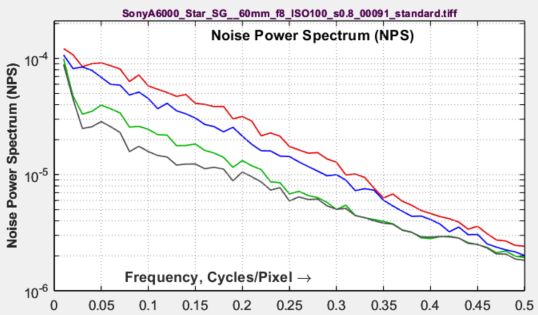 |
Noise Equivalent Quanta (NEQ)The standard NEQ used in the plot is based on the mean signal voltage, Vmean, shown above. A different voltage, VP-P /sqrt(12), is used to calculate NEQ-based information capacity, CNEQ. The NEQ plot is rough because of the relatively small size of the slanted-edge ROIs (Regions of interest). |
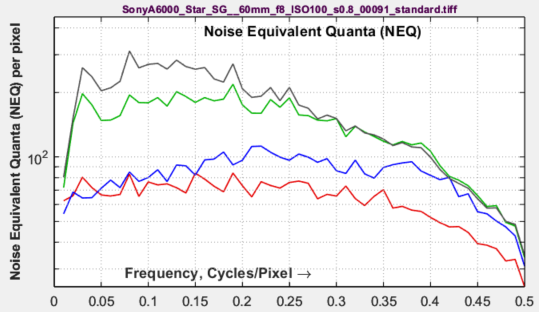 |
Modulation Transfer Function (MTF)Available here for convenience. It looks a little different from the standard MTF plot because the y-axis is logarithmic. |
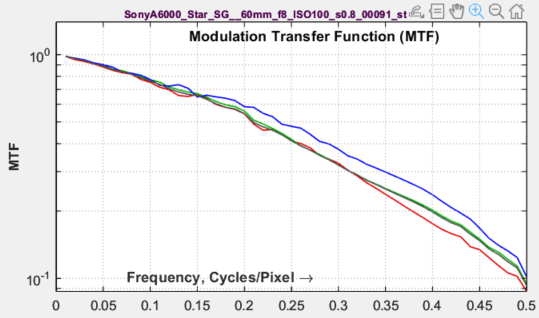 |
Edge voltage unnormalizedDisplayed primarily to check input for the NEQ calculation. It’s often interesting to compare peak-to-peak amplitudes of the different channels. |
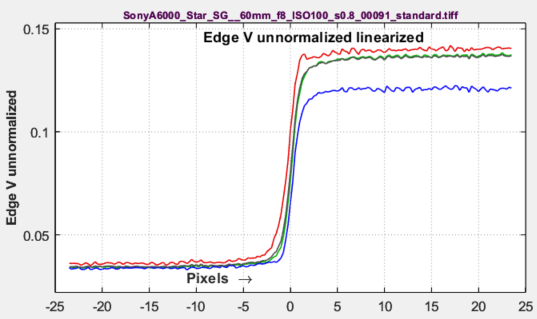 |
Noise autocorrelation (experimental)This plot has been included more for R&D than for regular testing. The author (NLK) added it to examine his hypothesis that the noise power spectrum (and autocorrelation) indicate the amount of electrical crosstalk of image sensor when the effects of demosaicing and fixed-pattern noise are removed (not the case for the image on the right) and the primary noise source is photon shot noise. The idea behind the hypothesis is that light incident on the sensor is entirely uncorrelated, so that if there were no crosstalk the noise would be white. This image on the right was white-balanced. The curve is the inverse Fourier transform of the noise spectrum, based on the author’s limited understanding of the Wiener-Khinchin theorem. |
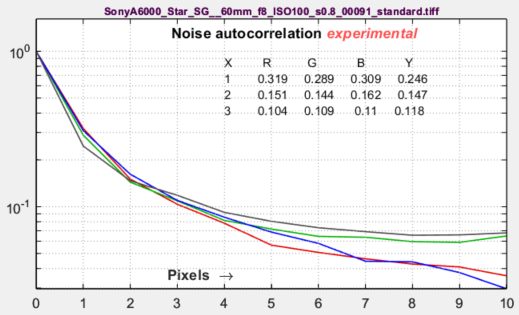 |
The image on the right is not White-Balanced. The red channel has a larger autocorrelation distance than the other channels, as we would expect. Click on the image to enlarge it.A similar autocorrelation plot can also be obtained from a flat field image in the Image Statics module. The relatively large autocorrelation (>1.3) at large distances (>4 pixels) is a definite concern.
|
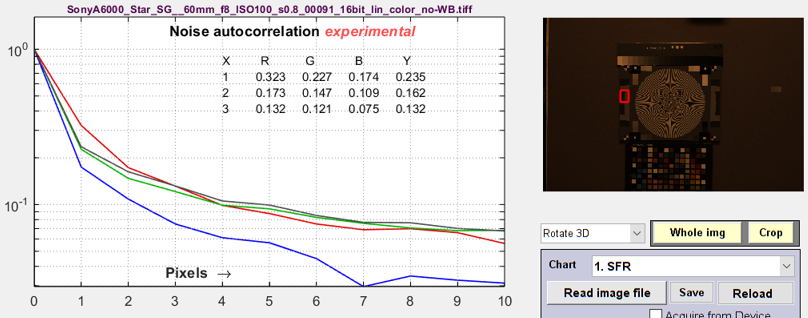 |
Lower plots
Ideal observer Signal-to-Noise Ratio (SNRi)SNRi is an indicator of the detectability of small objects. It can be displayed for three feature types: a square of sides w and rectangles of sizes w × 2w and w × 4w for w = the smaller side in pixels. SNRi is a new addition to Imatest. We’ll have more to say about it when we gain experience in using and interpreting it. It is discussed in detail in papers by Paul Kane [8] and Orit Skorka and Paul Kane [9]. |
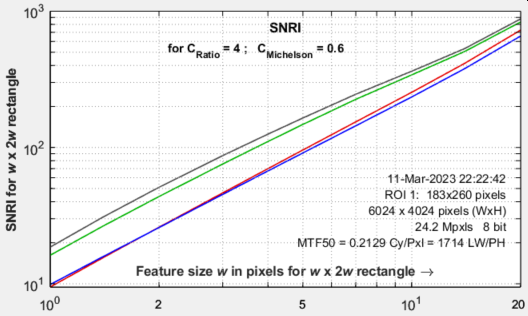 |
|||
Image crops (original, de-binned, noise)These full image crops are shown below. We illustrate crops here for a noisy image (ISO 12800), where the difference between the original and de-binned image is easy to see. The images are all gamma-encoded for display. The noise image on the right has been lightened and contrast-boosted. The effectiveness of the de-binning for removing noise is impressive.
|
|
|||
Results summaryThe first two lines contain a summary of image properties. The bottom group of lines contain several variables used in program development to check the accuracy of the calculations. The primary results are the Information capacities in the middle. C4(EdgeVar) and Cmax(EdgeVar) are derived from the Edge Variance method. C4(NEQ) and Cmax(NEQ) are derived from the the Noise image method (designated NEQ because they are calculated directly from NEQ). They are close but not identical because the Noise image method uses the measured Noise Power Spectrum, while the Edge Variance method assumes white noise power. |
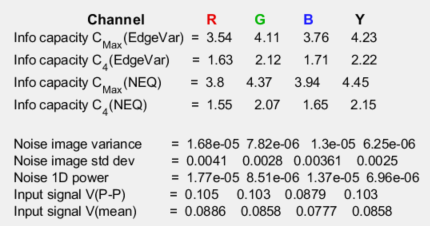 |
Summary
- Shannon information capacity C has long been used as a measure of the goodness of electronic communication channels. It specifies the maximum rate at which data can be transmitted without error if an appropriate code is used (it took nearly a half-century to find codes that approached the Shannon capacity). Coding is not an issue with imaging. Rodney Shaw’s paper from 1962 [10] is a particularly good example of measuring C for photographic film— it wasn’t easy back then.
- C is ordinarily measured in bits per pixel. The total capacity is \( C_{total} = C \times \text{number of pixels}\).
- The channel must be linearized before C is calculated, i.e., an appropriate gamma correction (signal = pixel level gamma, where gamma ~= 2 for images in standard color spaces such as sRGB or Adobe RGB) must be applied to obtain correct values of S and N. The value of gamma (close to 2) can be determined from runs of any of the Imatest modules that analyze grayscale step charts: Stepchart, Colorcheck., Color/Tone, Multitest, SFRplus, or eSFR ISO. But in most cases it can be determined from the edge image if the chart contrast is entered and Use for MTF is checked.
- We hypothesize that C can be used as a figure of merit for evaluating camera quality, especially for machine vision and Artificial Intelligence cameras. (It doesn’t directly translate to consumer camera appearance because they have to be carefully tuned to reach their potential, i.e., to make pleasing images). It provides a fair basis for comparing cameras, especially when used with images converted from raw with minimal processing.
- Imatest calculates the Shannon capacity C for the Y (luminance; 0.212*R + 0.716*G + 0.072*B) channel of digital images, which approximates the eye’s sensitivity. It also calculates C for the individual R, G, and B channels as well as the Cb and Cr chroma channels (from YCbCr).
- Shannon capacity has not been used to characterize photographic images because it was difficult to calculate and interpret. But now it can be calculated easily, its relationship to photographic image quality is open for study.
- Since C is a new measurement, we are interested in working with companies or academic institutions who can verify its suitability for Artificial Intelligence systems.
|
Note: A slanted-edge information capacity measurement used prior to Imatest 2020, used primarily to obtain total information capacity from Siemens star measurements, has been deprecated completely because it was not sufficiently accurate. |
Links (more links in the White Paper)
- C. E. Shannon, “A mathematical theory of communication,” Bell Syst. Tech. J., vol. 27, pp. 379–423, July 1948; vol. 27, pp.
623–656, Oct. 1948. - C. E. Shannon, “Communication in the Presence of Noise”, Proceedings of the I.R.E., January 1949, pp. 10-21.
- Wikipedia – Shannon Hartley theorem has a frequency dependent integral form of Shannon’s equation that is applied to both Imatest’s sine pattern and slanted edge Shannon information capacity calculation.
- I.A. Cunningham and R. Shaw, “Signal-to-noise optimization of medical imaging systems”, Vol. 16, No. 3/March 1999/pp 621-632/J. Opt. Soc. Am. A
- Brian W. Keelan, “Imaging Applications of Noise Equivalent Quanta” in Proc. IS&T Int’l. Symp. on Electronic Imaging: Image Quality and System Performance XIII, 2016, https://doi.org/10.2352/ISSN.2470-1173.2016.13.IQSP-213.
- Michail C, Karpetas G, Kalyvas N, Valais I, Kandarakis I, Agavanakis K, Panayiotakis G, Fountos G., Information Capacity of Positron Emission Tomography Scanners. Crystals. 2018; 8(12):459. https://doi.org/10.3390/cryst8120459.
- Christos M. Michail, Nektarios E. Kalyvas, Ioannis G. Valais, Ioannis P. Fudos, George P. Fountos, Nikos Dimitropoulos, Grigorios Koulouras, Dionisis Kandris, Maria Samarakou, Ioannis S. Kandarakis, “Figure of Image Quality and Information Capacity in Digital Mammography”, BioMed Research International, vol. 2014, Article ID 634856, 11 pages, 2014. https://doi.org/10.1155/2014/634856.
- Paul J. Kane, “Signal detection theory and automotive imaging”, Proc. IS&T Int’l. Symp. on Electronic Imaging: Autonomous Vehicles and Machines Conference, 2019, pp 27-1 – 27-8, https://doi.org/10.2352/ISSN.2470-1173.2019.15.AVM-027.
- Orit Skorka, Paul J. Kane, “Object Detection Using an Ideal Observer Model”, IS&T Int’l. Symp. on Electronic Imaging: Autonomous Vehicles and Machines, 2020, pp 41-1 – 41-7, https://doi.org/10.2352/ISSN.2470-1173.2020.16.AVM-041.
- R. Shaw, “The Application of Fourier Techniques and Information Theory to the Assessment of Photographic Image Quality”, Photographic Science and Engineering, Vol. 6, No. 5, Sept.-Oct. 1962, pp.281-286. Reprinted in “Selected Readings in Image Evaluation,” edited by Rodney Shaw, SPSE (now SPIE), 1976. A fascinating and difficult calculation of information capacity of photographic film. Available for download
- X. Tang, Y. Yang, S. Tang, Characterization of imaging performance in differential phase contrast CT compared with the conventional CT: Spectrum of noise equivalent quanta NEQ(k), Med Phys. 2012 Jul; 39(7): 4467–4482. Published online 2012 Jun 29. doi: 10.1118/1.4730287
.
Appendix 1. Calculation summary and algorithms
This section contains a brief summary of the calculation. Results are shown below.
For more detail, read the white paper.
Motivation — We need to obtain information capacity from images that have very different types of image processing.
- Minimally or uniformly-processed images, converted from raw to TIFF or PNG files. By “minimally-processed”, we mean no sharpening, no noise reduction, at most a simple gamma curve (no complex tonal response curves). A color matrix may be applied (it affects noise and SNR, but not MTF). When available, these images give the most reliable information capacity measurements.
- JPEG files from cameras, which usually have bilateral filters — filters that sharpen images near contrasty features like edges but blur them to reduce noise elsewhere — making it appear that the image contains more information than it actually has. This improves conventional SNR measurements (made from flat patches) while actually removing information.
In late October 2022, we discovered how to extract signal-dependent noise from slanted-edges using an overlooked capability of the ISO 12233 slanted-edge algorithm, described briefly below and in more detail in the white paper, Measuring Camera Information Capacity from Slanted-edges.
In March 2023, we discovered a second overlooked capability that allows Imatest to calculate a camera’s Noise Power Spectrum (NPS), Noise Equivalent Quanta (NEQ), and Ideal Observer SNR (SNRi).
The slanted-edge method of calculating MTF, which has been part of the ISO 12233 standard since 2000, takes each scan line yl (x) in a slanted-edge Region of Interest (ROI), finds its center, fits a polynomial curve to the centers, then depending on the relation between the line center and the curve, adds the line contents to one of four bins.
The bins are then interleaved, resulting in a 4× oversampled averaged edge.
To calculate MTF (Modulation Transfer Function (usually synonymous with Spatial Frequency Response), the averaged edge is differentiated (resulting in the Line Spread Function, LSF), windowed, then Fourier-transformed. MTF is the absolute value of the Fourier Transform normalized to 1 (or 100%) at zero frequency.
The new information capacity measurements take advantage of overlooked capabilities of the slanted-edge method.
A. Edge variance method
Sum the squares of the scan lines to obtain the edge variance.
In addition to summing the scan lines, the squares of the scan lines are summed. This allows the variance of the edge, which is equivalent to the signal-dependent noise power, to be calculated.
\(\displaystyle \sigma_s^2(x) = \frac{1}{L} \sum_{l=0}^{L-1} (y_l(x)-\mu_s(x))^2 = \frac{1}{L}\sum_{l=0}^{L-1} y_l^2(x) \ – \left(\frac{1}{L}\sum_{L=0}^{L-1} y_l(x) \right)^2 \)
Signal-dependent noise (power σs2(x) and voltage σs(x)) is important because many images— including most JPEGs from consumer cameras— have bilateral filters, which sharpen the image (boosting noise) near sharp areas like edges, and blurs it (to reduce visible noise) elsewhere. This obscures the noise at edges, which is critical to the performance — and information capacity — of the system. The new technique makes signal-dependent noise near the edge visible so that it can be used in the information capacity calculation. It is also highly convenient.
After removing newly-discovered binning noise, selecting the best location to measure noise, and adjusting the signal level from the edge, which is a square wave, to be more representative of an “average’ signal, numbers are entered into the Shannon-Hartley equation (above) to calculate the information capacity, which is referenced to the chart contrast.
This explanation has been extremely compressed. The full explanation is in the white paper, Measuring Camera Information Capacity from Slanted-edges.
B. Noise image method
Subtract a low-noise reverse-projected / de-binned ROI image from the original image to obtain a noise image.
The 4× oversampled averaged edge, described above, was created by adding each scan line in the original ROI image (below, left) to one of four interleaved bins, each of which contains an averaged (noise-reduced) signal. It can be de-interleaved (de-binned or reverse-projected; the nomenclature isn’t final) by filling each line in a new image with the averaged signal of the corresponding interleave. This creates a low-noise replica of the original image (below-middle).
A noise image can be created by subtracting the reverse-projected image from the original image. The three images are shown below. The noise image (below-right), which has a mean value of 0, has been lightened and contrast-boosted for display. The three images are linear: a gamma curve has been applied for display.
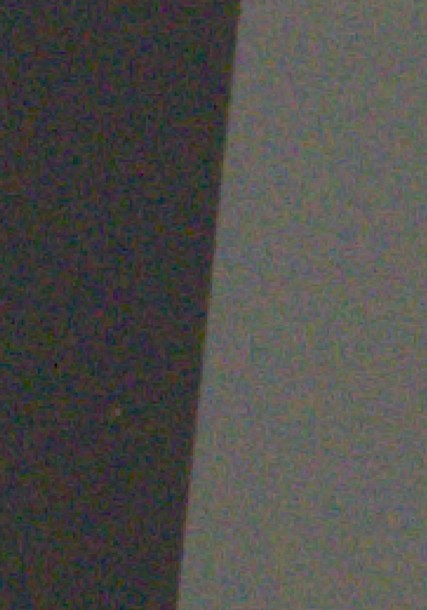 Original ROI Original ROI |
 Inverse-binned / de-interleaved / Inverse-binned / de-interleaved /reverse-projected ROI |
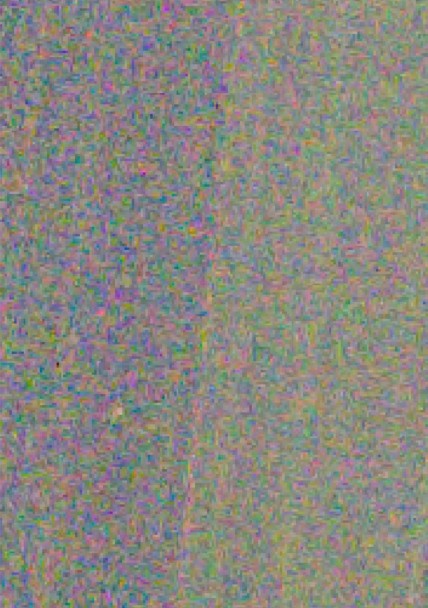 Noise image ROI Noise image ROI |
These images allow several key image quality parameters to be calculated, including Noise Power Spectrum and Noise Equivalent Quanta, well-known in medical imaging systems, and described in an excellent review paper by Ian Cunningham and Rodney Shaw [4]. These measurements are not well-known outside of medical imaging, largely because they have been difficult to measure.
Noise Power Spectrum (NPS) (the square of the Noise (voltage) spectrum) is calculated by taking the 2D Fourier transform of the noise ROI (Region of Interest) and noting that the initial 2D spectrum has zero frequency at the center of the image. A 1D Noise Power Spectrum, NPS1, is calculated by dividing the 2D spectrum into several annular regions (the number depends on the size of the ROI), then taking the average noise power of each region. This transformation allows calculations to be performed in one dimension (rather than two) under the assumption that the vertical and horizontal MTFs are close.
The relationship between NPS and the variance of the noise image is given in equations (3) and (8) of Cunningham and Shaw [4], which we have reduced to one dimension and with the integration limits changed from {-∞,∞} to {0, fNyq}, where fNyq = Nyquist frequency = 0.5 cycles/pixel.
\(\displaystyle \sigma^2 = \int_0^{f_{Nyq}} NPS(f) df \)
The 1D Fourier transform described above must be scaled to be consistent with the above equation.
\(\displaystyle NPS(f) = \frac{NPS_1(f)\ \sigma^2}{\displaystyle \int_0^{f_{Nyq}} NPS_1(f) df }\)
Noise Equivalent Quanta (NEQ) is a well-known figure of merit in medical imaging, but is unfamiliar in general imaging. It is described in a 2016 paper by Brian Keelan [5]. Essentially, it is a frequency-dependent Signal-to-Noise (power) Ratio. Units are the equivalent number of quanta that would generate the measured SNR when photon shot noise is dominant.
\(\displaystyle NEQ(f) = \frac{\mu^2 MTF^2(f)}{NPS(f)}\)
where the mean linear signal, μ, can be defined in either of two ways, depending on how NEQ is to be interpreted.
If NEQ is to be used for calculating DQE (Digital Quantum Efficiency), where \(DQE(f) = NEQ(f) / \overline{q}\), then μ should be the mean value of the linearized signal voltage in the original image. Measuring DQE requires a separate measurement of the mean number of quanta reaching each pixel. We may add this in the future.
A special form of NEQ, NEQinfo(f), calculated using \(\mu = V_{P-P}/\sqrt{12}\), is used to calculate information capacity, CNEQ, from a special case of the Shannon-Hartley equation. NEQinfo is not plotted.
\(\displaystyle C_{NEQ} = \int_0^W \log_2 \left( 1 + NEQ_{info}(f)\right) df\)
where bandwidth W is the camera’s Nyquist frequency, \(W = f_{Nyq} = 0.5 \text{ Cycles/Pixel}\). [Author’s note: I thought I’d discovered this connection, but it’s in papers on PET scanners and Digital Mammography by Christos Michail et. al. [6,7] Not papers anybody outside medical imaging is like to chance upon.]
Getting familiar with the meaning and use of NEQ will take some time. Characterization of imaging performance in differential phase contrast CT compared with the conventional CT: Spectrum of noise equivalent quanta NEQ(k) by Tang et. al. is an excellent example of how NEQ is used in medical imaging: it has real technical depth.
Ideal Observer SNR (SNRi) is a measure of the detectability of small objects. It is described in papers by Paul Kane [8] and Orit Skorka and Paul Kane [9]. Its equation is
\(\displaystyle SNRi^2 = \int{\frac{|G(\nu)|^2 MTF^2(\nu)}{NPS(\nu)} }d\nu \)
where spatial frequency ν has units of Cycles/Pixel, and the linearized signal is normalized to have a maximum value of 1.
G(υ) is the Fourier transform of the object to be detected, typically rectangles of dimensions w × kw, where k = 1 (for a square) or 2 or 4 for rectangles. Its amplitude (for now) is the peak-to-peak voltage of the slanted edge (shown in the Voltage statistics figure, above), \(\Delta Q = V_{P-P}\) which typically has a 4:1 contrast ratio.
\(\displaystyle \Delta g(x,y) = \Delta Q \cdot \text{rect}(x/w) \cdot \text{rect}(y/kw) \ \text{ where rect}(x) = 1 \text{ for } -1/2 < x < 1/2 \text{ ; 0 otherwise.}\)
\(\displaystyle G(\nu_x,\nu_y) = kw^2 \Delta Q \frac{\sin(\pi w \nu_x)}{\pi w \nu_x} \frac{\sin(\pi kw \nu_y)}{\pi k w \nu_y}\)
In one dimension, \(\displaystyle G(\nu) = kw^2 \Delta Q \frac{\sin(\pi w \nu)}{\pi w \nu} \frac{\sin(\pi kw \nu)}{\pi k w \nu}\)
G was reduced to one dimension (υ = υx υy) to simplify the analysis. G(υ)2 has the same units as NPS.
SNRi is displayed for each color channel for w from 1 to 20 in increments of approximately the square root of w (1, 1.4, 2, …).
Appendix 2: Meaning of Shannon information capacity
(The Appendix in the white paper, Measuring Camera Information Capacity with slanted-edges,
has a concise definition of information.)
In electronic communication channels the information capacity is the maximum amount of information that can pass through a channel without error, i.e., it is a measure of channel “goodness.” The actual amount of information depends on the code— how information is represented. But although coding is integral to data compression (how an image is stored in a file), it is not relevant to digital cameras. What is important is the following hypothesis:
Hypothesis: Perceived image quality (assuming a well-tuned image processing pipeline) and also the performance of machine vision and Artificial Intelligence (AI) systems, is proportional to a camera’s information capacity, which is a function of MTF (sharpness), noise, and artifacts arising from demosaicing, clipping (if present), and data compression.
I stress that this statement is a hypothesis— a fancy mathematical term for a conjecture. It agrees with my experience and with numerous measurements, but it needs more testing and veritication. Now that information capacity can be conveniently calculated with Imatest, we have an opportunity to learn more about it.
The information capacity, as we mentioned, is a function of both bandwidth W and signal-to-noise ratio, S/N.
|
In texts that introduce the Shannon capacity, bandwidth W is often assumed to be the half-power frequency, which is closely related to MTF50. Strictly speaking, W log2(1+S/N) is only correct for white noise (which has a flat spectrum) and a simple low pass filter (LPF). But digital cameras have varying amounts of sharpening, which can result in response curves with response that deviate substantially from simple LPF response. For this reason we use the integral form of the Shannon-Hartley equation: \(\displaystyle C = \int_0^W \log_2 \left( 1 + \frac{S(f)}{N(f)} \right) df = \int_0^W \log_2 \left(\frac{S(f)+N(f)}{N(f)} \right) df \) S and N are mean values of signal and noise power; they are not directly tied to the camera’s dynamic range (the maximum available signal). For this reason, we reference calculations of C to the contrast ratio of the chart used for the measurement, most frequently C4 for 4:1 contrast charts that conform to the ISO 12233 standard. For Siemens star analysis, we this equation was altered to account for the two-dimensional nature of pixels by converting it to a double integral, then to polar form, than back to one dimension. But this wasn’t necessary for slanted-edges, which are already one dimensional. |
The beauty of both the Siemens Star and Slanted-edge methods is that signal power S and noise power N are calculated from the same location: important because noise is not generally constant over the image.



